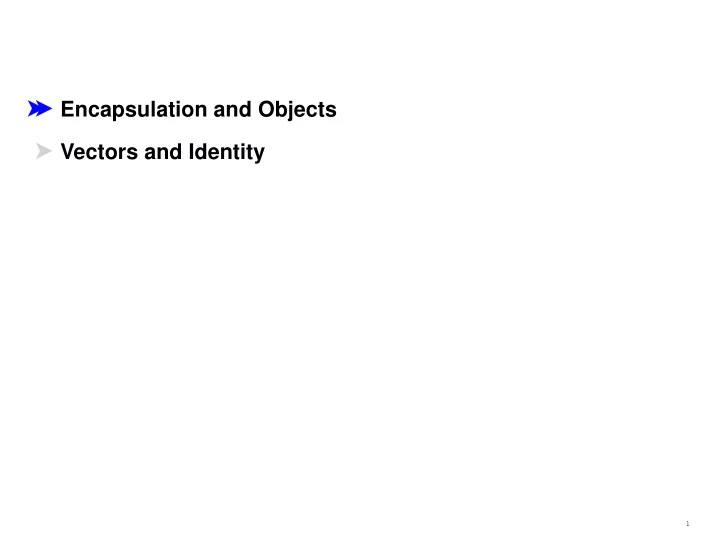

Encapsulation and Objects Vectors and Identity 1
Encapsulation Two lectures ago, we encapsulated a fish with a GUI: ; A live-fish is ; (num -> num) ; make-fish : num -> live-fish (define (make-fish init-weight) (local [(define WEIGHT init-weight) (define (feed n) ...) ...] (begin (create-window ...) feed))) By returning feed , we enable programs that process groups of fish 2-3
Objects Maybe we don't need the GUI, but we'd like to represent fish identities (define alice (new-fish 7)) (define bob (new-fish 6)) (define norman (new-fish 12)) (define my-favorite-fish (list alice norman)) (define all-my-fish (list alice bob norman)) (alice 4) "should be" 11 ((first my-favorite-fish) 0) "should be" 11 ((first all-my-fish) 0) "should be" 11 Copy 4
Objects Maybe we don't need the GUI, but we'd like to represent fish identities ; A fish-object is ; (num -> num) ; new-fish : num -> fish-object (define (new-fish init-weight) (local [(define WEIGHT init-weight) (define (feed n) (begin (set! WEIGHT (+ WEIGHT n)) WEIGHT))] feed)) Copy 5
Armadillos How about armadillos? ; new-dillo : num bool -> (num -> num) (define (new-dillo init-weight init-alive?) (local [(define WEIGHT init-weight) (define ALIVE? init-alive?) (define (feed n) (begin (set! WEIGHT (+ WEIGHT n)) WEIGHT))] feed)) We can feed a dillo this way, but we can't check whether it's alive... 6-7
Armadillos (define (new-dillo init-weight init-alive?) (local [(define WEIGHT init-weight) (define ALIVE? init-alive?) (define (feed n) (begin (set! WEIGHT (+ WEIGHT n)) WEIGHT)) (define (is-alive?) ALIVE?) (define (set-alive a?) (set! ALIVE? a?))] ... feed ... is-alive? ... set-alive ...)) How can we return three functions? 8-9
Armadillo Objects ; A dillo-object is ; (make-dillo (num -> num) (-> bool) (bool -> void)) (define-struct dillo (feed is-alive? set-alive)) ; new-dillo : num bool -> dillo-object (define (new-dillo init-weight init-alive?) (local [(define WEIGHT init-weight) (define ALIVE? init-alive?) (define (feed n) (begin (set! WEIGHT (+ WEIGHT n)) WEIGHT)) (define (is-alive?) ALIVE?) (define (set-alive a?) (set! ALIVE? a?))] (make-dillo feed is-alive? set-alive))) Copy 10
Armadillo Object Examples (define cindy (new-dillo 5 true)) (define dan (new-dillo 8 true)) ((dillo-feed cindy) 2) "should be" 7 ((dillo-feed dan) 1) "should be" 9 ((dillo-feed cindy) 0) "should be" 7 ; run-over! : dillo -> void (define (run-over! d) ((dillo-set-alive d) false)) ((dillo-alive? dan)) "should be" true (run-over! dan) "should be" (void) ((dillo-alive? dan)) "should be" false ((dillo-alive? cindy)) "should be" true Copy 11
Disallowing Armadillo Resurrection ; A dillo-object is ; (make-dillo (num -> num) (-> bool) (-> void)) (define-struct dillo (feed is-alive? run-over!)) ; new-dillo : num bool -> dillo-object (define (new-dillo init-weight init-alive?) (local [(define WEIGHT init-weight) (define ALIVE? init-alive?) (define (feed n) (begin (set! WEIGHT (+ WEIGHT n)) WEIGHT)) (define (is-alive?) ALIVE?) (define (run-over!) (set! ALIVE? false))] (make-dillo feed is-alive? run-over!))) 12
General Pattern for Encapsulating Objects ; A THING -object is ; (make- THING method-type ...) (define-struct THING ( METHOD ...)) ; new- THING : init-type ... -> THING -object (define (new- THING init-val ...) (local [(define STATE init-val ) ... ; METHOD : method-type (define ( METHOD arg ...) ...)] (make- THING METHOD ...))) Note: implementation depends on the operations (a.k.a. methods) that you want 13-14
Encapsulation Encapsulation • Groups related functions with data • Controls access/modification of state Encapsulation is a key idea behind languages like Java Still, one other idea is more important: Data-driven design This is what you know One more idea is equally important: Extensible data definitions We'll see this soon 15-17
Encapsulation and Objects Vectors and Identity 18
The Truth about Vectors A vector is an object with state (define v (vector 'a 'b 'c)) (vector-ref v 0) "should be" 'a (vector-set! v 0 'd) (vector-ref v 0) "should be" 'd 19
A Zoo with Cage Let's keep our armadillos in cages • Each cage holds one armadillo • If we have 5 cages, we can represent the set of cages with a vector of size 5 (define cages (vector false false false false false)) (define cindy (new-dillo 5 true)) (define dan (new-dillo 8 true)) (vector-set! cages 0 cindy) (vector-set! cages 1 dan) 20
Moving Armadillos • Implement move-dillo which takes a dillo-object and a cage number, and move the dillo to the cage number ; move-dillo : dillo-object n -> void ; continuing from the previous example (move-dillo cindy 3) "should be" (void) (vector-ref cages 3) "should be" cindy 21-22
Moving Armadillos First attempt: (define (move-dillo d n) (vector-set! cages n d)) Problem: the dillo is still in its old cage (move-dillo cindy 3) "should be" (void) (vector-ref cages 3) "should be" cindy (vector-ref cages 0) "should be" false ; but currently we get cindy 23-24
Finding and Moving Armadillos (define (move-dillo d n) (begin (vector-set! cages ... false) (vector-set! cages n d))) 25
Finding and Moving Armadillos (define (move-dillo d n) (begin (vector-set! cages (find-dillo d) false) (vector-set! cages n d))) ; find-dillo : dillo -> num (define (find-dillo d) ...) 26
Finding and Moving Armadillos (define (move-dillo d n) (begin (vector-set! cages (find-dillo d) false) (vector-set! cages n d))) ; find-dillo : dillo -> num (define (find-dillo d) (find-dillo-at d 0)) ; find-dillo-at : dillo num -> num (define (find-dillo-at d n) (cond [(same? d (vector-ref cages n)) n] [else (find-dillo-at d (add1 n))])) 27
Comparing Armadillos ; same? : dillo-object dillo-object -> bool (define (same? d1 d2) (and (= ((dillo-feed d1) 0) ((dillo-feed d2) 0)) (boolean=? ((dillo-alive? d1)) ((dillo-alive? d2))))) (define eddie (new-dillo 7 true)) (define fran (new-dillo 7 true)) (same? eddie fran) "should be" true But that's not right — eddie and fran are different armadillos 28-29
Detecting an Armadillo If d1 and d2 are the same, then feeding d1 should grow d2 : (define (same? d1 d2) (local [(define orig-d2-size ((dillo-feed d2) 0))] (begin ((dillo-feed d1) 1) (local [(define later-d2-size ((dillo-feed d2) 0))] (begin ((dillo-feed d1) -1) (> later-d2-size orig-d2-size)))))) Granted, this is a harsh way to compare armadillos, so Advanced provides eq? (define (same? d1 d2) (eq? d1 d2)) 30-31
Recommend
More recommend